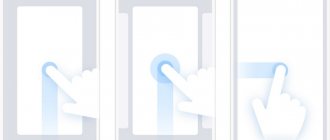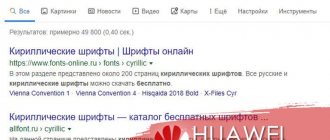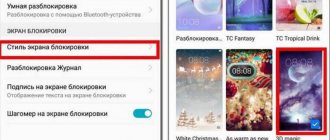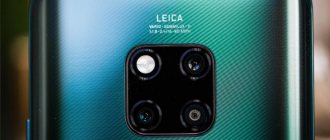The buffer zone is the lower part of the screen of a Huawei smartphone, which ensures the display of various notifications or banners. They can be either active or non-clickable, representing advertising or explanatory text in applications and browsers.
Buffer zone in Android phones
For those who still don’t understand: a buffer zone in Android is, roughly speaking, an insert into games or applications that announces a third-party project. Some utilities offer to pay to remove ads, but sometimes pop-ups can be very useful.
For example, they notify you about new achievements or changes in the game or work program, being an indispensable part of future progress. A striking example of such a function is MNPHelper, which allows you to configure the display of a telecom operator for incoming calls. This is suitable for managers and people who constantly negotiate and are not used to raising unnecessary numbers.
To simplify the explanation, let's look at buffer zone manipulation using the pop-up window problem as an example. Recently, Huawei Ascend P6S/P7 users have been complaining about an error when trying to display the information block. Owners of other Huawei models also experience similar inconveniences.
The setup is carried out in several stages:
- Launch Phone Manager (in English firmware – PhoneManager).
- Find the “Tools” item or the thematic icon in the upper right corner of the menu (English version – Settings).
- In the window that opens, select “DropZone Management”.
Setting permissions in the buffer zone of a Huawei phone - All you have to do is select the application that is experiencing problems from the list and disable it - you’re almost done. It is recommended to restart the phone after all previous manipulations.
Setting up access to the buffer zone
Bugs with a buffer zone are noticeable even to an inexperienced user - ordinary advertising or useful information is replaced by an awkward white footnote. Depending on the smartphone model, it contains different text, but it always leads the owner to thoughts about problems. Unfortunately, this will be much more difficult for owners of English-language firmware to understand.
As mentioned earlier, the buffer zone is a very controversial feature in Android. On the one hand, it can be useful and irreplaceable in everyday life, but sometimes, on the contrary, it interferes with enjoying your favorite toy or preparing the necessary information in time.
In any case, it is not always possible to remove it - even if you disable the application in the smartphone settings, the annoying error can begin to become an eyesore with unprecedented force. True, the latter happens extremely rarely. We hope that our article helped you understand the unfamiliar Huawei function - good luck!
Many owners of smartphones produced under the Huawei brand are faced with the concept of a “buffer zone in the phone.”
Naturally, they have a number of questions to which users are looking for answers:
- What is this anyway?
- What is it for?
- How to use it?
In our article we will try to provide complete information regarding this very interesting function. It is one of the differences between the smartphone and this manufacturer.
What do Huawei representatives say about the buffer zone?
Fortunately, Huawei always tries to pay attention to communicating with its consumers. And for this there is absolutely no need to visit the company’s representative offices. There are official forums of this brand on the Internet, on the pages of which representatives of the manufacturer answer questions asked.
It is not surprising that one of the owners of such a mobile phone once asked what this buffer zone is? And I received an answer. What information did you find out:
- The buffer zone in a Huawei phone is a small section of the screen specially allocated at the bottom;
- Used to show a variety of messages that inform a person about something. Most often found in gaming applications created for the Android OS;
- Notifications from the operator are sent to the same place when any request is sent.
That is, according to the information received. This part of the screen is used to transmit certain information to the owner of the mobile phone.
What does this look like in reality?
So what does this mean in simple examples? As already written above, this zone is most often used in a variety of gaming software. It looks like this:
- A person installs some kind of game on his phone;
- Launches and begins to pass;
- The program may already have some messages integrated into it, or it will create them as the game character develops, or when certain goals are achieved;
- In the first case, it may be an advertisement for some other product from the game developer. Or a call to purchase a more recent, full version of the application currently in use;
- Secondly, information is displayed at the bottom of the screen that the user has moved to the next level, earned a hundred coins, or received some unique game item.
Often such information is as informative as possible. Therefore, it is useful for humans.
The second option for using this functionality in Android OS:
- The owner of the mobile phone decided to check the status of his account in terms of the availability of funds on it;
- To do this, most people enter a special command on their phone to get the required answer;
- The operator receives the request, processes it and sends a response;
- And he appears exactly in this place. That is, the user does not need to close other applications or go to the folder with received SMS messages in order to read what was received.
But what if the information that should be obtained in this way is not displayed correctly?
Reviews
Considering the great popularity of phones of this brand, it is not surprising that there are quite a lot of reviews in which people share about this functionality:
- Olga. Personally, I knew for a long time that there was a so-called buffer zone in my phone, but I did not see the advantages of its presence. As they say - another useless functionality that could be replaced with something else. But then one day a friend advised me to install a program on my smartphone. It's called MNPHelper. This software allows you to display additional information about the incoming call at the bottom of the screen. Very convenient, considering that my professional activity is directly related to numerous telephone conversations.
- Peter. I can’t answer for sure whether such an opportunity is needed at all. For example, I just recently switched from a push-button mobile phone to a smartphone and somehow got used to reading all messages through a folder. And I do the same with my new one. Even if they are initially displayed at the bottom of the screen.
- Fedor. For me, my gadget is a working tool. Literally nowhere without him. I constantly use it for communication; I always have a bunch of applications open where I’m doing something. And it’s very convenient when, when communicating in a chat, there is no need to constantly switch to it to see whether the interlocutor answered me and what exactly. Thanks to the work of the buffer zone, all answers come to me exactly there. Convenient and comfortable. I really like this solution from Huawei.
- Ignat. I understand very little about modern technology. And then my son gave me a touchscreen mobile phone for my birthday. Naturally, I asked him to download various programs for me. Fulfilled the request. At first everything worked great. But then some of them stopped making me happy. Again I asked my son to help. Came. It turned out that I was too clever with the settings. For example, I disabled the buffer zone everywhere, which was simply necessary for some of the applications I used. And they worked great after a simple activation. In general, my son advised me not to go into the settings at all without it - there’s nothing for me to do there, they say.
- Anton. I partly like to play various mobile games. And this feature seems quite useful. Allows you to find out, for example, whether I completed the task or not, what achievements I achieved, and so on. What is important is that all this does not distract from direct immersion in the game. Well, if you encounter entertainment that is oversaturated with advertising, then I simply go into the settings and disable the ability to use this area of the screen. It's simple!
As you can see, most people assessed this potential positively, some – neutrally. There are very few negative attitudes, so we can say that the buffer zone in Huawei phones is a very good solution.
Settings
To enable or disable the buffer zone:
- enter the Phone Manager application;
- click on the “Buffer zone” item;
- if it is missing, click on the settings icon in the upper right corner of the screen;
- select the “Buffer zone management” option;
- activate or deactivate the checkbox next to applications in the list that opens.
If the described procedure is completed correctly, “Allowed” or “Blocked” will appear under the selected game or program. Depending on the option selected, applications will be granted or denied access to send notifications and display advertising banners.
The buffer zone in Huawei Honor is a controversial feature, because when active, it does not completely remove banners, but makes them unclickable. Information that appears as advertising is hidden. It is replaced by a white footnote, which, however, complicates the operation of the smartphone.
Some applications that do not have permission to the buffer zone may not launch, even if they are compatible with the model of the smartphone you are using. This is due to the fact that it displays not only advertising, but also important notifications on which the performance of programs depends.
What is a buffer zone in a Huawei and Honor smartphone? A similar question arises for every user who is faced with an application request to allow the use of the mentioned zone. In such situations, the first step is to understand what permission the program needed. Perhaps the security of sensitive data will be at risk, so access should not be approved?
Fortunately, everything is not so complicated and dangerous. In reality, the access granted to the application will allow the subscriber to use all the functions of the program. The security of the smartphone will not be affected. But the convenience of using the phone may decrease, so owners of Android devices need to know how to manage the buffer zone and control access of third-party services to it.
Solving possible problems
It should be said that the functionality of certain programs that users can run on Honor and Huawei devices largely depends on access to an additional unit. Some gadget owners constantly experiment with equipment settings, so they may prohibit access to the buffer zone. After this, problems appear with the software, the inability to launch programs or their incorrect operation, which is associated with restrictions.
To resolve problems, you may need the following instructions:
- Go to the smartphone application manager or “PhoneManager”.
- Click on the icon and go to a new menu, where you select the “Tools” section.
- In it, select the window labeled “Buffer zone management.” This transition makes it possible to see a list of all programs that are in the device’s memory and use the functionality of the information block.
Now you will need to carefully read the list and activate the sliders if, without the information block, the application cannot start or does not function correctly. In this area, you can also deactivate the option if it is not very important or prevents the owner from using all the features of the programs. You can watch the video in detail about the phone manager, using Honor 6 as an example.
There is another method for solving problems if the described option is not suitable. It is worth noting that phones are equipped with a duplicate option called “Overlay on top of other windows.” Disabling it in the application allows you to disable the display of information blocks. You can go to the settings of this parameter like this:
- In an application that is having problems, you need to find the section corresponding to the settings. To find the right software, you need to go to “Applications and notifications”, activate the applications tab and find what you need.
- In the settings there will be a line “Overlay on top of other windows”, click on it.
- In the new menu, you can enable or disable the function using a slider.
If the described area is deactivated, the buffer zone will not work.
Vyacheslav
For several years he worked in mobile phone stores of two large operators. I understand tariffs well and see all the pitfalls. I love gadgets, especially Android ones.
Ask a Question
Question to the expert
Do all developers use the buffer zone for advertising?
No, only a certain category. There are applications from Google Play that do not use this area for work.
Can there be failures when disabling the buffer zone?
Yes, if the function is deactivated for some games or applications, their further functioning may not be correct.
The buffer zone is a special function of Honor and Huawei devices, which cannot be called unambiguous. On the one hand, it is useful and can show important information every day, but there are situations when the opportunity prevents you from playing or fully using the program.
4.6 / 5 ( 33 voices)
0
What is the buffer zone in Honor and Huawei phone?
The buffer zone in Huawei and Honor phones is a special intermediate area of the smartphone, located “on top of the applications in use.” In simple terms, the mentioned area refers to that layer of the screen that is always in the foreground. As a result of its use by certain programs, some of their functionality will remain visible even when other services are enabled. Such a solution will help Honor owners maintain access to the necessary functions, regardless of how the gadget is currently used. But it should be taken into account that using a buffer zone has not only advantages, but also disadvantages: some open programs and information located on the screen will be hidden by the icon in the foreground.
Building Buffer Zones in MapInfo Pro
Imagine that you need to create an area that covers properties within 440 meters on either side of a highway, or define an area that contains families with preschool-aged children who are within 5 km of a selected school. The process of creating such an area is called creating a buffer zone. This zone itself is called a buffer.
Two buffering tools
Mapinfo Pro 17 has two different commands for creating buffers. They are located on the OBJECTS tab. These are the Buffer Objects and Buffer Zone Table tools.
Region objects created during buffering can be saved directly in the cosmetic layer or to an existing table by selecting the Buffer Objects command. It is important to note that the buffer will be saved to any currently edited layer.
The Buffer Zone Table command provides the ability to create a new table to store buffering objects. You can specify an entire table of objects to buffer without having to select them first. The operation of this tool is discussed in more detail in another article.
Buffer example
Let's look at the construction of buffer zones using the example of some Sydney swimming pools that are free for public use and surrounding shops that sell a variety of swimsuits and swimming equipment.
When you select the Buffer Objects tool, the following dialog box appears:
In the map below, the smoothing value was chosen to be 12. This low number was chosen specifically to highlight the impact of this value on the resulting object. To create a smoother buffer, you can select a much higher value (maximum 500).
The buffer below has been saved into a cosmetic layer, you can change the transparency of this layer by right-clicking on the layer and selecting Layer Properties. Don't forget to save the buffer(s) created in the cosmetic layer with:
Map > Cosmetic > Save Cosmetic Objects.
It is often more useful to store buffer objects instead of a cosmetic layer in one or more tables so that the opacity of the layers can be changed in different ways for visual purposes. This can be especially useful if multiple buffers are required, each requiring different levels of transparency. This will also make it possible to control the order of layers, which is important for selecting objects into the buffer.
This can be done by selecting the Buffer > Buffer Zone Table command located on the OBJECTS tab. Before moving on to the buffer creation dialog, this command will walk you through the process of creating a new table.
If you have multiple objects selected for buffering, you can create one buffer for each object or one buffer for all objects.
Creating one buffer for each object, in the example below, leads to the appearance of 3 buffers and, accordingly, 3 new entries in the table. The default colors of objects are different from each other to highlight their differences. You can change the colors by double-clicking in the buffer area and choosing a new area style.
Creating one buffer for all features creates one region feature that spans the 3 selected basins.
You can use the Bounds Selection tool to select objects in the buffer. (It can be found on the MAP and FEATURES tabs or in the mini toolbar).
The Boundary Selection tool will select features that are in the topmost layer, so clicking inside the buffer means that features in the Pools layer that are in that buffer area will be selected.
When you move up the Stores layer, the Border Selection tool selects all the stores that are in the buffer area.
Data summarization
Since the buffer is an object that is added to the table as a new record, the record will have all the fields required by the structure of the table.
All columns from the source table are transferred to the resulting table, unless the “No data” checkbox is selected. How the values in each result column are calculated depends on the disaggregation method you select for it. “Empty”—empty values are placed in the fields of new objects. The value from the source column can be transferred to the column of the resulting object using the “Value” method. “Do not include data”—data is not transferred to new objects.
You can buffer any map objects. Here are some examples:
- Fiber Optic Cable Buffer to find homes that can receive phone and internet services.
- A buffer of protected areas to identify areas where construction is or is not yet possible.
- A buffer of the locations of different stores as a basis for comparison.
Buffering has a huge number of potential applications. Remember this when you need to analyze the location of objects on the map relative to some other objects.
Setting up and managing the buffer zone
Setting up the buffer area is extremely simple and contains only 2 main functions:
- allow services to access the screen;
- restrict programs' access to the zone.
How to enable/disable key sound on Honor and Huawei
The absence of other functions can be explained very simply: the mentioned area is transparent, that is, invisible to users, used only by Honor and Huawei programs and RAM. That is, it is impossible to perform other actions, regardless of the subscriber’s wishes. In addition, the area is purely auxiliary in nature and does not have an independent purpose that would allow expanding the existing functionality.
Phone Manager
It is important to emphasize that there are 2 main ways to manage a buffer zone. The first is to use a phone manager. To configure the service you will need:
- Open your desktop and find the mentioned application.
- Go to the “buffer zone” section.
- After which the user will see a list of programs and applications installed on the system.
- Next to each application there is a slider that allows you to turn access to the buffer zone on or off.
For the convenience of smartphone owners, at the top is the exact number of programs that have received permission to use the option. As a result, a person will know whether he should look for programs that need to be disabled (connected), or whether setting up the service is complete.
Settings menu
You can also control the zone through the application settings menu. To do this, just open the list of programs installed on Android and select the one you need from the downloaded list. After that, all that remains is to find the “overlay on top of windows” item in the list of available actions and decide whether to allow such an option. The exchange of the used option for another occurs using the standard method, by clicking on the function and changing the decision to “yes” or “no”. Nothing additional is required to manage the service.
On our website, we also talk about various menu items that are of interest to users. Today we will talk about the so-called buffer zone on a Huawei or Honor smartphone based on Android. What is it and what is it for, this zone?
In this case, the buffer zone is the lower area of the screen where software (applications) can display notifications. However, it should be noted that the notifications themselves are not active and are for informational purposes only. Yes, it could be an advertisement, but not a clickable one; however, the user is unlikely to like it when advertisements or other unnecessary messages pop up on the screen out of the blue.
Why is a buffer zone needed?
The main task lies with the information component. The auxiliary block is needed to contain the following information:
- Data about the program that was opened and used.
- Showing new products and announcements.
- Advertising of services or goods.
- Show sites that have been used previously.
- Displaying goods or services that the user was previously interested in. The selection is carried out automatically based on created requests.
The buffer zone is not a full-fledged place for advertising; it is a separate area in which the content cannot be opened by simply clicking on the picture.
The advantages include:
- The ability to enable or disable additional tools at your own request.
- High degree of information content.
- The block takes up a minimum amount of space.
- Availability of useful tips.
The main drawback is the inability to use a regular touch to open detailed information on a message or advertisement. Such information has almost no effect on the device’s memory, so it does not clog it with files and is not viral. The user can control the appearance of notifications and disable them. Such tasks lie entirely with the owner of the smartphone.
Virus blocks, applications and notifications are completely different from information ones, since they destroy the device’s shell (OS), and also reduce the size of the internal memory, and generally cause a lot of harm.
Setting up a buffer zone on a smartphone
Find “Application Manager” on your desktop and open it.
Next, open the “Buffer Zone” section.
Here you will see a list of applications that can open the buffer zone.
If you want to disable them all or some individual applications, simply move the switch next to the application to the “Off” position, for example:
Thus, the specified application will not be able to open the buffer zone, that is, send notifications.
Sources used:
- https://devicess.ru/bufernaya-zona-v-telefone-huawei-chto-eto/
- https://windows-azbuka.ru/obshhie-voprosy/bufernaya-zona-v-telefone-huawei-chto-znachit/
- https://www.lumias.ru/chto-takoe-bufernaya-zona-v-huawei-honor/
- https://mobi-insider.com/chto-takoe-bufernaya-zona-v-telefone-huawei-i-honor.html
- https://siteproandroid.ru/bufernaja-zona-v-huavej-i-honor-na-android-chto-jeto/
SHARE Facebook
- tweet
Previous articleWhat is the difference between iPhone Xr and Xs? iPhone comparison
Next articleHow display resolution works and what it affects
How to set up a buffer zone
Setting up a buffer zone is easy and there are 2 options for this. In general, this terminology refers to the usual disabling of an information block or individual applications. To work, you will need to use the “Manager application” or the smartphone settings menu. In the first case, the algorithm will be as follows:
- There is an “Application Manager” on the home screen of an Honor or Huawei smartphone. To work, you need to launch it by tapping on the icon.
- A menu will appear in which the “Buffer Zone” section will be available.
- By going to the new menu, a list of programs opens that may require an auxiliary information window.
- You should disable those that are not needed to use and the procedure is over.
After this operation, the selected applications will not display data at the bottom of the screen. If you use the settings menu, the algorithm will be slightly different:
- You need to go to “Settings” on your device.
- Find the section with applications and tap on it. In the open menu, the selection must be repeated according to the previously described instructions.
- In the list of programs, select the one you need, for example, the Yandex browser.
- The “About” tab will open, go down a little and find “Display on top of other applications”.
- All that remains is to disable the function, and the job is done.
This option is shown only in technical programs that are needed to support the buffer zone. The described actions allow you to enable or disable blocks of information and advertising in games or applications. Some software features of smartphones are presented in the video










